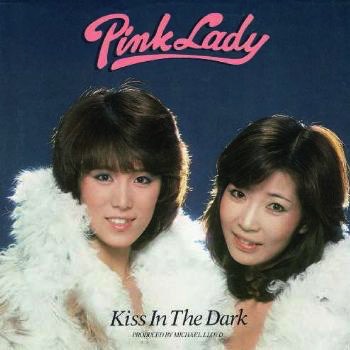ESSAY 23
"KISS IN THE DARK": THE CHART TOPPER THAT SHOULD'VE BEEN BUT WASN'T
by Jeffrey C. Branch

It was forty years ago this month that history of sort was made: a Japanese group broke into the Billboard Top 40 with an English language single. That group, of course, was Pink Lady, and the single was “Kiss in the Dark”, a Disco themed song written and produced by music impresario Michael Lloyd. Searching back in my memories, and clippings I obtained while I was stationed in Norfolk, Virginia while in the Navy, I learned in March or April that Mie and Kei were to break into the U.S. music market with their first English single (the album would follow later), having conquered Japan by selling millions of chart topping records and performing before sold out audiences in baseball stadiums, PL’s American handlers at Elektra/Curb Records arrived at the conclusion that Mie and Kei could conquer the U.S. market as well. Well, that was the plan anyway, but things didn’t quite pan out in the end.
The first time I heard KITD, a fast paced, toe tapping number was when the Ladies made their U.S. debut on the Leif Garrett Special in May of 1979. I had only learned about that show a mere week before it aired and was lucky to have seen it on a quiet Friday night on the ship I was stationed on, and while I wasn’t aware of it at the time, that appearance was marketing genius. In 1979, Garrett was one of the hottest teen idols around, with his good looks and singing talents he was all over the covers of teen magazines, so it was a given that kids would tune in to his special, and when they did, they got to see the Ladies who, as far as I could tell from what I had seen, wowed the crowd, and wowed me as well since that had been the first time I saw Mie and Kei on a TV screen since early December of 1978 before I left Japan, they looked just as wonderful as ever. As for the song itself, I had heard Mie and Kei sing in English before, mainly during their concerts, but in a studio recording, the girls sounded supremely polished, their harmonies flat out amazing, and even though it was said they sung phonetically as their grasp of the language was dubious at best, it was hard to discern much, if anything in the way of an accent. Of course, it probably didn’t hurt to have had a mastermind in the booth like Lloyd, working controls to make the girls sound their very best.
When KITD made its debut on June 2nd, the reviews were split, some found it charming, primarily due to the appeal of Mie and Kei who carried the day thanks to their looks and innocent, girlish charm, and yeah, I won’t deny there was also the curiosity factor of two Japanese girls who barely spoke passable English singing a Disco tune. Then there were others who dismissed the song as Disco pablum, nothing different or innovative from years worth of songs that came before, from reviews I’ve read, a rough consensus of sorts seemed to lean towards KITD being liked more than disliked. Meanwhile, thanks to their appearance on the Leif Garrett Special, Mie and Kei had attracted lots of interest from teens who watched the show and liked them right away, finding them cute and wanting to learn more, leading to articles about them in Life magazine and Rolling Stone. By mid-Juneor so, the inconceivable took place, KITD broke into the Billboard Top 100, stations were giving the song airplay and interest in Pink Lady seemed to be growing, by mid June, the song cracked the Top 40 at #37 and looked be streaking, drawing what was then the inevitable question of if Pink Lady could become the first Japanese singer to hit number one on the charts since “Sukiyaki” by Kyu Sakomoto in 1963. The sky seemed to be the limit. Could Pink Lady conquer America like they had Japan?
Unfortunately, the answer to that question was no. The very next week, KITD not only dropped out of the Top 40, it disappeared from the charts altogether, literally overnight, the song was gone, never to be heard again. At the time, I was across the Atlantic on my ship in a Mediterranean cruise, so I wasn’t able to fully follow what had happened, but, two decades later after I launched the website, I formed my own opinion as to why KITD vanished, it’s an opinion I’ve espoused on the site time and time again: the Ladies were the victims of frustratingly bad timing. By the time KITD cracked the Top 40 in June of ‘79, Disco was already on its deathbed, thanks to over saturation as seemingly EVERYONE was cutting songs, hell, even Dolly Parton went down that road for crissakes, the public, to put it bluntly, had enough and were ready for something fresh and new. I’ve said here on the site scores of times and will continue saying until the day I shuffle off this mortal coil, if KITD had been released a year, or even six months sooner than it had, it would’ve done much better than it had, I’m convinced the song could well have gone all the way to number one on the charts, earning Pink Lady fame in THE biggest music industry on the planet. Well, at least their fifteen minutes worth as most acts who hit it big with Disco songs ended up being one hit wonders.
Of course, this wasn’t the end of Mie and Kei’s adventures in America as Pink Lady & Jeff would come along the following year, but their attempt to break into the U.S. music market in a big way with KITD fizzled, and, sadly, they never tried again. Over the years, I’ve indulged in lots of “what if” scenarios, beyond what if KITD was released sooner than it had, what if another genre other than Disco had been utilized? Could PL’s handlers had gone with pop, soft rock, soul or R & B instead? Anything that didn’t have the dwindling shelf life Disco had? We’ll never know, but I saw it as an opportunity that had been missed for the Ladies to become a household name in the States, even if but for a brief period of time. Still, at the end of the day, it had been a fun time with KITD and Pink Lady back then, and I sure enjoyed the experience.
